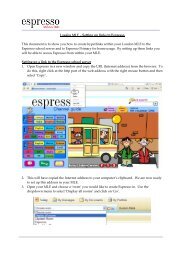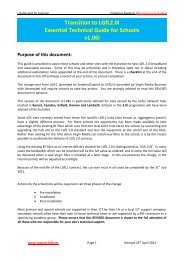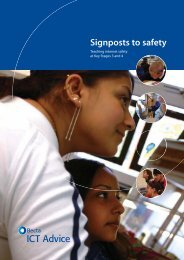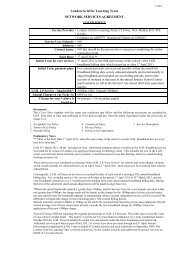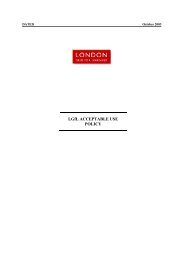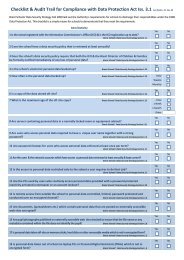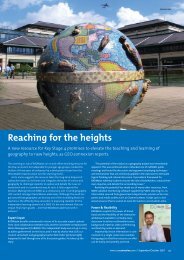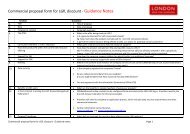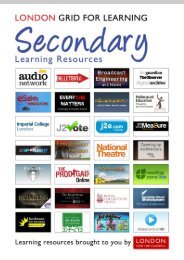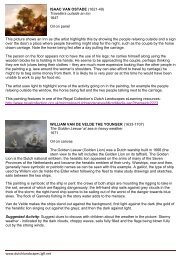Say no to bullying
Say no to bullying
Say no to bullying
You also want an ePaper? Increase the reach of your titles
YUMPU automatically turns print PDFs into web optimized ePapers that Google loves.
Give each child a blank full-face mask shape. On one side, draw or paint the faceof a character in a s<strong>to</strong>ry showing a happy face <strong>to</strong> the world. On the other side,show the hidden, inner emotions. The masks could be fastened <strong>to</strong> sticks <strong>to</strong> turnfrom one side <strong>to</strong> the other and be used when retelling the s<strong>to</strong>ry.Alternatively, puppets could be constructed with two-sided heads that canchange from one expression <strong>to</strong> a<strong>no</strong>ther.ICT follow-upObjectivesTo retrieve information that has been s<strong>to</strong>red, for example using a CD-ROMTo try things out and explore what happens in real and imaginary situationsTo explore a variety of ICT <strong>to</strong>olsYear 5 children will be using an interactive s<strong>to</strong>ry resource as part of their work on<strong>bullying</strong>. The CD-ROM resource allows children <strong>to</strong> click on a character in the s<strong>to</strong>ryand <strong>to</strong> access that character’s thoughts and/or feelings. You could organise for agroup of Year 5 children <strong>to</strong> come and demonstrate the CD-ROM resource <strong>to</strong>groups of Year 2 children, with a particular focus on the thoughts and feelings ofthe children who are bullied, at key points in the s<strong>to</strong>ry. This activity would link verywell with the suggested art and design activities described above.Literacy follow-upActivity 1ObjectivesTo identify and discuss reasons for events in s<strong>to</strong>ries (Y2 T1 T5) (or, if you areusing this theme in the summer term: To write sustained s<strong>to</strong>ries, using theirk<strong>no</strong>wledge of s<strong>to</strong>ry elements (Y2 T3 T10))We are a primaryschool, and usedthe Year 5 pairingsas the basis for a‘buddying’ systemin which theyounger childrencould go <strong>to</strong> theirdesignated ‘buddy’in the playground ifthey felt worried, orfor specialactivities.Ideally this activity could be undertaken after the children have had the suggestedICT input from Year 5. Using the ICT <strong>to</strong>ol, the children could click on a character<strong>to</strong> see how they are feeling and what they are thinking.Children could make up their own ‘lift the flap’ s<strong>to</strong>ry-books about a child who isbullied. They could show how he or she looked on the outside, and what theydid, but use ‘lift the flap’ over the character’s face or heart <strong>to</strong> ‘look in<strong>to</strong>’ what thecharacter is feeling. This can raise the issue that sometimes people act in oneway, but feel differently (for example, laughing along when you are called names,but inside feeling hurt and upset). Alternatively, the ‘lift the flaps’ could show theperson being bullied saying something positive <strong>to</strong> him or herself (e.g. ‘This is <strong>no</strong>tmy fault. I’m OK.’).Activity 2ObjectivesTo identify and discuss reasons for events in s<strong>to</strong>ries (Y2 T1 T5) (or, if you areusing this theme in the summer term: To read, respond imaginatively, recommendand collect examples of humorous s<strong>to</strong>ries (Y2 T3 T6))Text: The Wild Washerwomen by John Yeoman and Quentin Blake (Picture Puffin)ISBN 0140503676 19© Crown copyright 2005 <strong>Say</strong> <strong>no</strong> <strong>to</strong> <strong>bullying</strong> Years 1 and 2DfES 1340-2005Primary National Strategy




